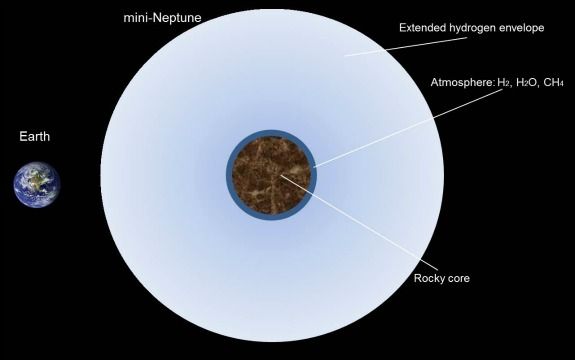“Earth-Like” Exoplanets May Actually Be Mini-Neptunes
Many newly discovered exoplanets may not be able to shed their dense hydrogen atmospheres, making them unsuitable for life
/https://tf-cmsv2-smithsonianmag-media.s3.amazonaws.com/filer/Surprising-Science-Expoplanet-NASA-631.jpg)
The discovery of planets beyond our solar system, along with recent efforts to catalog them, has fueled the search for rocky planets similar to Earth that may have conditions suitable for life. For the past 20 years, many scientists have focused on locating “super-Earths“–planets heavier than Earth but with masses quite a bit below that of Neptune or Uranus–in the so-called “habitable zone” of their stars. Within this zone, it is theoretically possible for a planet with the right atmospheric pressures to maintain liquid water on its surface.
In early January, astronomers working on NASA’s Kepler Mission announced the discovery of KOI 172.02 (KOI for Kepler Object of Interest), an exoplanet candidate that is about 1.5 times the radius of Earth, orbiting in the habitable zone of a G-type star slightly cooler than our Sun. If confirmed, the planet, which orbits its sun every 242 days, is “our first habitable-zone super Earth around a sun-type star,” astronomer Natalie Batalha, a Kepler co-investigator at NASA’s Ames Research Center, told Space.com. Batalha and colleagues hail KOI 172.02 as the exoplanet most like Earth, and thus is a prime candidate for hosting life, they expect.
But don’t get too excited–new research suggests that most of these super-Earths may never support life because they are permanently encased in hydrogen-rich atmospheres. The findings, released yesterday in the Monthly Notices of the Royal Astronomical Society, show that these super-Earths may actually be mini-Neptunes. Further, these exoplanets will likely never evolve to look like Mercury, Venus, Earth, or Mars–the rocky planets of our inner solar system.
Led by Helmut Lammer of the Austrian Academy of Sciences’s Space Research Institute (IWF), researchers examined how radiation from the stars Kepler-11, Gliese 1214 and 55 Cancri would effect on the upper atmospheres of the super-Earths orbiting too close to their host stars to be in the habitable zone. These super-Earths have sizes and masses that indicate they have rocky interiors surrounded by hydrogen-rich atmospheres–atmospheres that were likely captured early in the planet’s history from the clouds of dust and gas that formed the systems’ nebulae.
Using a model that simulates the dynamic properties of planetary atmospheres, the researchers showed how the extreme ultraviolet light from the host stars heat up the exoplanets’ atmospheres, and as a result, the atmospheres expand several times the radius of each planet, allowing gases to escape. But not fast enough.
“Our results indicate that, although material in the atmosphere of these planets escapes at a high rate, unlike lower mass Earth-like planets many of these super-Earths may not get rid of their nebula-captured hydrogen-rich atmospheres,” Lammer said in a statement.

If their model is correct, its implications spell doom for life on exoplanets further out, in the ‘habitable zone.’ Although temperatures and pressures would allow liquid water to exist, gravity and an inability for their suns to blow off their atmospheres would forever preserve their thick hydrogen-rich atmospheres. Thus, they probably could not sustain life.
Scientists may have to wait until 2017–after the European Space Agency launches the Characterising Exoplanets Satellite (CHEOPS)–before they can learn whether these findings stand the test of time. CHEOPS. Until then, the search for exoplanets with conditions ripe for life has gotten a lot harder.
/https://tf-cmsv2-smithsonianmag-media.s3.amazonaws.com/accounts/headshot/mohi-kumar-240.jpg)
/https://tf-cmsv2-smithsonianmag-media.s3.amazonaws.com/accounts/headshot/mohi-kumar-240.jpg)